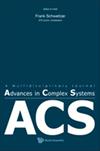Combining Algorithmic Information Dynamics Concepts and Machine Learning for Electroencephalography Analysis: What Can We Get?
IF 1
4区 数学
Q4 MATHEMATICS, INTERDISCIPLINARY APPLICATIONS
引用次数: 0
Abstract
Electroencephalography (EEG) as an example of electrophysiological monitoring methods has a rather long history of successful application for the diagnosis and treatment of diseases, and this success would not have been possible without effective methods of mathematical, and more recently, computer analysis. Most of these methods are based on statistics. Among the methods of EEG analysis, there is a group of methods that use different versions of Shannon’s entropy estimation as a “main component” and that do not differ significantly from traditional statistical approaches. Despite the external similarity, another approach is to use the Kolmogorov–Chaitin definition of complexity and the concepts of algorithmic information dynamics. The algorithmic dynamics toolbox includes techniques (e.g., block decomposition method) that appear to be applicable to EEG analysis. The current paper is an attempt to use the block decomposition method along with the recent addition to the management of EEG data provided by machine learning, with the ultimate goal of making this data more useful to researchers and medical practitioners.结合算法信息动力学概念和机器学习进行脑电图分析:我们能得到什么?
脑电图(EEG)作为电生理监测方法的一个例子,在疾病的诊断和治疗方面有着相当长的成功应用历史,如果没有有效的数学方法和最近的计算机分析,这种成功是不可能的。这些方法大多是基于统计的。在脑电图分析的方法中,有一组方法使用不同版本的香农熵估计作为“主成分”,与传统的统计方法没有显著差异。尽管外部相似,另一种方法是使用Kolmogorov-Chaitin对复杂性的定义和算法信息动力学的概念。算法动力学工具箱包括似乎适用于脑电图分析的技术(例如,块分解方法)。目前的论文是尝试使用块分解方法以及最近增加的机器学习提供的EEG数据管理,最终目标是使这些数据对研究人员和医疗从业者更有用。
本文章由计算机程序翻译,如有差异,请以英文原文为准。
求助全文
约1分钟内获得全文
求助全文
来源期刊

Advances in Complex Systems
综合性期刊-数学跨学科应用
CiteScore
1.40
自引率
0.00%
发文量
121
审稿时长
6-12 weeks
期刊介绍:
Advances in Complex Systems aims to provide a unique medium of communication for multidisciplinary approaches, either empirical or theoretical, to the study of complex systems. The latter are seen as systems comprised of multiple interacting components, or agents. Nonlinear feedback processes, stochastic influences, specific conditions for the supply of energy, matter, or information may lead to the emergence of new system qualities on the macroscopic scale that cannot be reduced to the dynamics of the agents. Quantitative approaches to the dynamics of complex systems have to consider a broad range of concepts, from analytical tools, statistical methods and computer simulations to distributed problem solving, learning and adaptation. This is an interdisciplinary enterprise.
 求助内容:
求助内容: 应助结果提醒方式:
应助结果提醒方式:


